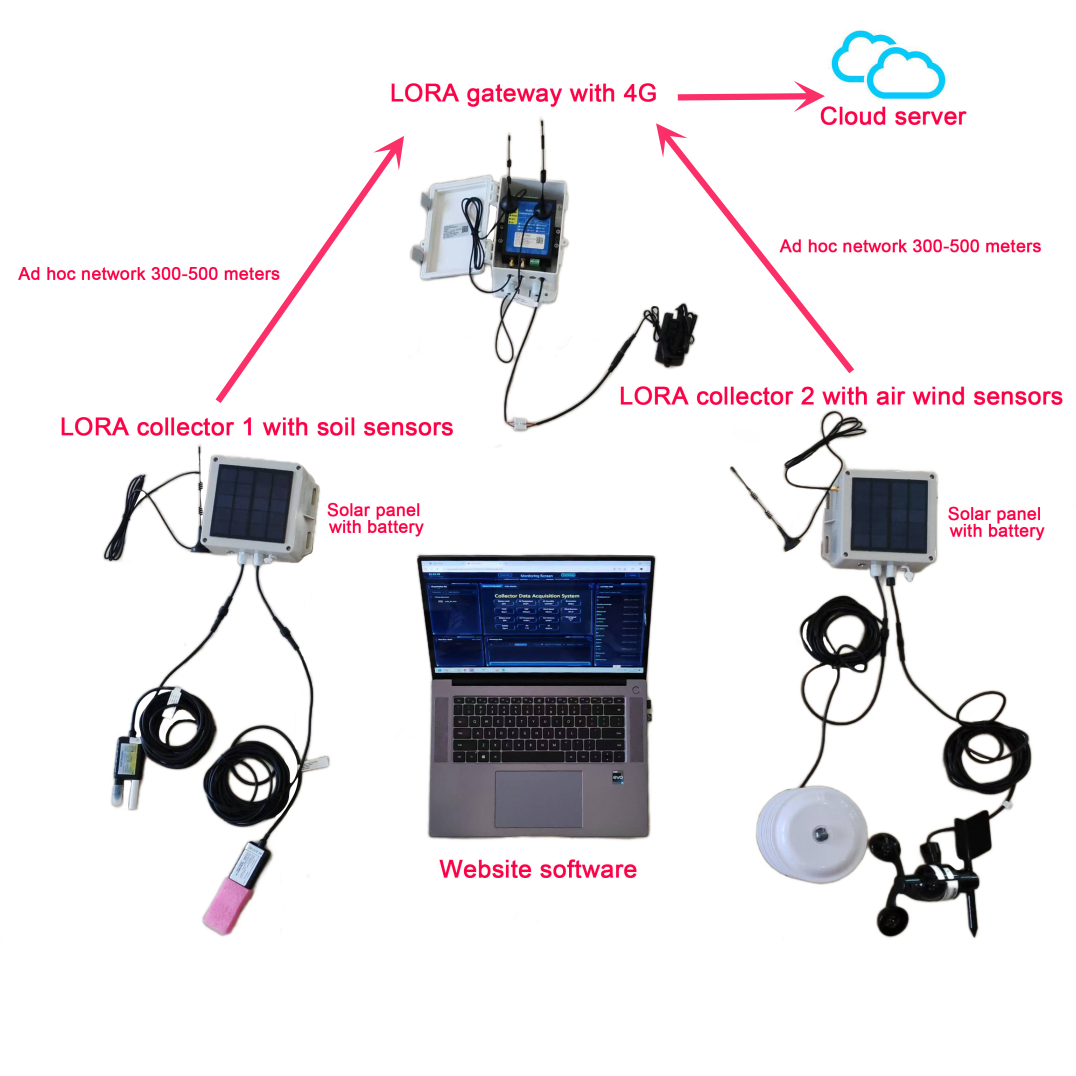Isishwankathelo semveliso
I-8 kwi-1 sensor yomhlaba yiseti yeeparamitha zokusingqongileyo zokubona kwenye yezixhobo zezolimo ezihlakaniphile, ukubeka iliso ngexesha langempela lobushushu bomhlaba, ukufuma, i-conductivity (ixabiso le-EC), ixabiso le-pH, i-nitrogen (N), i-phosphorus (P), i-potassium (K) umxholo, ityuwa kunye nezinye izikhombisi eziphambili, ezifanelekileyo kwezolimo ezihlakaniphile, ukutyalwa ngokuchanekileyo, ukubeka iliso kokusingqongileyo kunye nezinye iindawo. Uyilo lwayo oludibeneyo luyisombulule iintlungu zentlungu ye-sensor yendabuko efuna ukuhanjiswa kwezixhobo ezininzi kwaye inciphisa kakhulu iindleko zokufumana idatha.
Inkcazo ebanzi yemigaqo yobugcisa kunye neeparamitha
Ukufuma komhlaba
Umgaqo: Ngokusekelwe kwindlela ye-dielectric eqhubekayo (i-teknoloji ye-FDR / TDR), umxholo wamanzi ubalwa ngesantya sokusasazwa kwamaza ombane we-electromagnetic emhlabeni.
Uluhlu: 0 ~ 100% Volumetric Water Content (VWC), ukuchaneka ±3%.
Ubushushu bomhlaba
Umgaqo: I-thermistor echanekileyo ephezulu okanye i-chip yeqondo lokushisa yedijithali (njenge-DS18B20).
Uluhlu: -40℃~80℃, ukuchaneka ±0.5℃.
Ukuqhutywa koMbane (ixabiso leEC)
Umgaqo: Indlela ye-electrode ephindwe kabini ilinganisa i-ion concentration yesisombululo somhlaba ukubonisa ityuwa kunye nesiqulatho sesondlo.
Uluhlu: 0 ~ 20 mS / cm, isisombululo 0.01 mS / cm.
ixabiso pH
Umgaqo: Indlela yeglasi ye-electrode yokubona umhlaba pH.
Uluhlu: pH 3 ~ 9, ukuchaneka ± 0.2pH.
I-nitrogen, i-phosphorus kunye ne-potassium (NPK)
Umgaqo-siseko: I-Spectral reflection okanye i-ion selective electrode (ISE) iteknoloji, esekelwe kwi-wavelengths ethile yokukhanya kokukhanya okanye i-ion concentration ukubala umxholo wezondlo.
Uluhlu: N (0-500 ppm), P (0-200 ppm), K (0-1000 ppm).
ubutyuwa
Umgaqo: Ukulinganisa ukuguqulwa kwexabiso le-EC okanye inzwa ekhethekileyo yetyuwa.
Uluhlu: 0 ukuya kwi-10 dS/m (enokulungiswa).
Inzuzo engundoqo
Ukuhlanganiswa kweeparamitha ezininzi: Isixhobo esisodwa sithatha indawo ye-sensors ezininzi, ukunciphisa ubunzima be-cabling kunye neendleko zokugcina.
Ukuchaneka okuphezulu kunye nokuzinza: Ukukhuselwa kwibakala le-Industrial (IP68), i-electrode enganyangekiyo kwi-corrosion, ilungele ukuhanjiswa kwexesha elide.
Uyilo lwamandla aphantsi: Ukuxhasa ukunikezelwa kwamandla elanga, kunye ne-LoRa / NB-IoT yokuhanjiswa kwe-wireless, ukunyamezela iminyaka engaphezu kwe-2.
Uhlalutyo lwe-fusion yedatha: Inkxaso yokufikelela kwiplatifomu yefu, inokudibanisa idatha yemeteorological ukuvelisa iingcebiso zokunkcenkceshela / zokuchumisa.
Imeko yesicelo eqhelekileyo
Ityala loku-1: Ukunkcenkceshela okuchanekileyo kwifama
Umboniso: Isiseko esikhulu sokutyala ingqolowa.
Usetyenziso:
Izivamvo zihlola ukufuma komhlaba kunye netyuwa ngexesha lokwenyani, kwaye ngokuzenzekelayo ziqalisa inkqubo yokunkcenkceshela ngokuthontsiza kwaye zityhale iingcebiso zesichumiso xa ukufuma kuwela ngaphantsi komqobo (ofana ne-25%) kwaye ubutyuwa buphezulu kakhulu.
Iziphumo: I-30% yokonga amanzi, i-15% yokwanda kwesivuno, ingxaki ye-salinization ithotyiwe.
Ityala lesi-2: Amanzi e-Greenhouse kunye nokuhlanganiswa kwesichumisi
Umboniso: Indawo yokulima engenamhlaba yetomato.
Usetyenziso:
Ngexabiso le-EC kunye nedatha ye-NPK, umlinganiselo wesisombululo sezondlo wawulawulwa ngamandla, kwaye iimeko ze-photosynthetic zalungiswa ngokubeka iliso lokushisa kunye nomswakama.
Iziphumo: Izinga lokusetyenziswa kwezichumisi linyuke nge-40%, umxholo weswekile yeziqhamo unyuke nge-20%.
Ityala lesi-3: Ukugcinwa okukrelekrele kohlaza lwasezidolophini
Umboniso: Ingca yepaki kamasipala kunye nemithi.
Usetyenziso:
Ukubeka iliso kwi-pH yomhlaba kunye nezondlo kwaye udibanise iinkqubo zokutshiza ukuthintela ukubola kweengcambu okubangelwa kukunkcenkceshela ngokugqithisileyo.
Iziphumo: Iindleko zokulondolozwa kwamahlathi zincitshiswe ngama-25%, kwaye izinga lokusinda kwezityalo ngama-98%.
Ityala lesi-4: Ukujongwa kolawulo lobuntlango
Umboniso: Iprojekthi yokubuyisela indalo kwindawo eyinkqantosi kumntla-ntshona weTshayina.
Usetyenziso:
Utshintsho lokunyakama komhlaba kunye netyuwa yalandwa ixesha elide, isiphumo sokulungiswa kwesanti yezityalo savavanywa, kwaye isicwangciso sokutyala kwakhona sakhokelwa.
Idatha: Isiqulatho sezinto eziphilayo zomhlaba zonyuke ukusuka kwi-0.3% ukuya kwi-1.2% kwiminyaka emi-3.
Iingcebiso zokusasazwa kunye nokuphunyezwa
Ubunzulu bofakelo: Luhlengahlengiswa ngokokwabiwa kweengcambu zesityalo (ezifana ne-10–20cm kwimifuno yeengcambu ezingenzulwanga, 30–50cm kwimithi yeziqhamo).
Ukulungiswa kokulungiswa: iinzwa ze-pH/EC kufuneka zilinganiswe ngolwelo olusemgangathweni rhoqo ngenyanga; Coca ii-electrodes rhoqo ukuze ugweme ukungcola.
Iqonga ledatha: Kucetyiswa ukuba usebenzise i-Alibaba Cloud IoT okanye i-ThingsBoard iqonga ukuze uqaphele ukubonwa kwedatha ye-multi-node.
Ixesha elizayo
Ingqikelelo ye-AI: Dibanisa iimodeli zokufunda koomatshini ukuqikelela umngcipheko wokuthotywa komhlaba okanye umjikelo wokuchumisa kwezityalo.
I-Blockchain traceability: Idatha ye-Sensor idibaniswe nokubonelela ngesiseko esithembekileyo sokuqinisekiswa kwemveliso yezolimo.
Isikhokelo sokuthenga
Abasebenzisi bezoLimo: Ngokukhethekileyo khetha i-anti-interference eqinile ye-EC / pH sensor kunye ne-App yohlalutyo lwedatha yendawo.
Amaziko ophando: Khetha iimodeli ezichanekileyo eziphezulu ezixhasa i-RS485 / SDI-12 ujongano kwaye zihambelana nezixhobo zelabhoratri.
Ngokusebenzisa i-multi-dimensional data fusion, i-8-in-1 inzwa yomhlaba ilungisa ngokutsha imodeli yokwenza izigqibo zolawulo lwezolimo kunye nokusingqongileyo, ibe "i-stethoscope yomhlaba" ye-digital agro-ecosystem.
Ixesha lokuposa: Feb-10-2025


